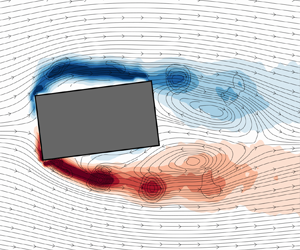No CrossRef data available.
Published online by Cambridge University Press: 04 November 2024

This work experimentally investigates the flow structure around a rectangular cylinder with an aspect ratio of 2 under varying incidence angles to examine how acoustic perturbations modify and modulate the unsteady flow instabilities. In the absence of acoustic excitation, the angle of incidence is found to markedly influence the flow topology and the natural shedding pattern altering the vortex formation length and wake dynamics. With acoustic perturbations, it is observed that for incidence angles  $\alpha = 0^{\circ }$ and
$\alpha = 0^{\circ }$ and  $\alpha = 5^{\circ }$, the masked impinging leading-edge vortex (ILEV)/trailing-edge vortex shedding (TEVS) instability modes of
$\alpha = 5^{\circ }$, the masked impinging leading-edge vortex (ILEV)/trailing-edge vortex shedding (TEVS) instability modes of  $n= 1$ and
$n= 1$ and  $n= 2$ become evident when their frequencies coincide with the frequencies of the acoustic perturbations (i.e. resonant condition). Both trailing-edge and leading-edge vortices were found to be modulated by the acoustic pressure cycle. These instability modes, which are naturally present under non-resonant conditions for significantly higher aspect ratios, highlight the role of incidence angle and self-excited acoustic resonance in virtually augmenting the streamwise length of the cylinder, thereby facilitating the emergence and sustenance of the ILEV/TEVS shedding pattern.
$n= 2$ become evident when their frequencies coincide with the frequencies of the acoustic perturbations (i.e. resonant condition). Both trailing-edge and leading-edge vortices were found to be modulated by the acoustic pressure cycle. These instability modes, which are naturally present under non-resonant conditions for significantly higher aspect ratios, highlight the role of incidence angle and self-excited acoustic resonance in virtually augmenting the streamwise length of the cylinder, thereby facilitating the emergence and sustenance of the ILEV/TEVS shedding pattern.